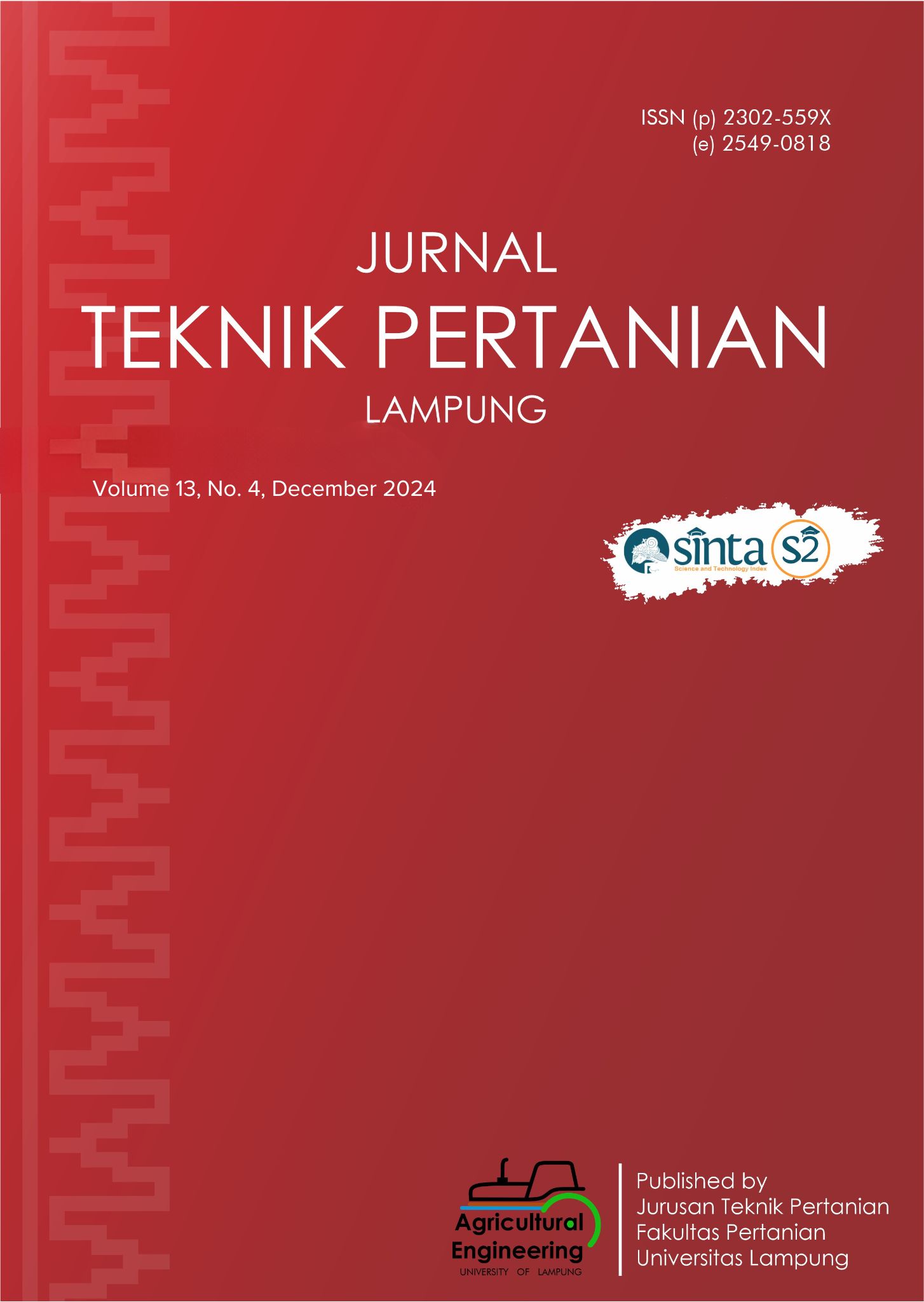Artificial Lighting System Design with PWM Control for the Growth of Kangkung Microgreen
DOI:
https://doi.org/10.23960/jtep-l.v13i4.1249-1261Abstract
Microgreen plants such as lettuce, spinach, and kangkung can be cultivated indoors, with artificial lighting like Light Emitting Diodes (LEDs) replacing sunlight. This study compared the growth of kangkung microgreens under artificial lighting using Pulse Width Modulation (PWM) versus without PWM. Two sample trays, each containing 50 grams of kangkung seeds, were placed 50 cm below the light. The first tray used PWM lighting, starting with a 65% duty cycle at 8 a.m, increasing to 100% by 12 p.m, and decreasing back to 65% by 4 p.m. The second tray received constant lighting without PWM. Results showed that PWM improved power efficiency from 16.3 W without PWM to 13.36 W with PWM. Growth of kangkung microgreens improved with PWM, evidenced by better stem length, leaf count, wet weight, stem diameter, petiole length, and leaf width, although single root length with PWM (9.68 cm) was slightly shorter than without PWM (9.98 cm).Base on statistical t-test results showed that there was a significant difference in stem length between lighting treatments using the PWM method and without using the PWM method, with a significance level of 5%. The study successfully developed an automated lighting control system using PWM that enhances plant growth.
Keywords: Artificial lighting, Indoor farming, Kangkung, Microgreen, Pulse wave modulation.
References
Al-Kodmany, K. (2018). The vertical farm: A review of developments and implications for the vertical city. Buildings, 8(2), 24. https://doi.org/10.3390/buildings8020024
As’adiya, L., & Murwani, I. (2021). Pengaruh lama penyinaran lampu led merah, biru, kuning terhadap pertumbuhan microgreen kangkung (Ipomoea reptant). Folium : Jurnal Ilmu Pertanian, 5(1), 14. https://doi.org/10.33474/folium.v5i1.10358
Avgoustaki, D.D., & Xydis, G. (2020). Chapter one - How energy innovation in indoor vertical farming can improve food security, sustainability, and food safety? Advances in Food Security and Sustainability, 5, 1–51. https://doi.org/10.1016/bs.af2s.2020.08.002
Balogh, L. (2017). Fundamentals of mosfet and igbt gate driver circuits application report. Texas Instruments, 1–48.
Bhaswant, M., Shanmugam, D.K., Miyazawa, T., Abe, C., & Miyazawa, T. (2023). Microgreens – A comprehensive review of bioactive molecules and health benefits. Molecules, 28(2), 867. https://doi.org/10.3390/molecules28020867
Dimita, R., Min Allah, S., Luvisi, A., Greco, D., De Bellis, L., Accogli, R., Mininni, C., & Negro, C. (2022). Volatile compounds and total phenolic content of perilla frutescens at microgreens and mature stages. Horticulturae, 8(1). https://doi.org/10.3390/horticulturae8010071
Dimitrov, S., Tane, J.,Despatis, J., Polli, M., Clemens, D., & Stoffgen, P. (2024). TimerOne. Arduino Reference. https://www.arduino.cc/reference/en/libraries/timerone/
Jin, W., Ji, Y., Larsen, D.H., Huang, Y., Heuvelink, E., & Marcelis, L.F.M. (2023). Gradually increasing light intensity during the growth period increases dry weight production compared to constant or gradually decreasing light intensity in lettuce. Scientia Horticulturae, 311, 111807. https://doi.org/10.1016/j.scienta.2022.111807
Liu, J., & van Iersel, M.W. (2021). Photosynthetic physiology of blue, green, and red light: light intensity effects and underlying mechanisms. Frontiers in Plant Science, 12, 619987. https://doi.org/10.3389/fpls.2021.619987
Lubis, F.B., & Yanie, A. (2022). Implementasi Pulse width modulation (pwm) pada penyaluran limbah cair pupuk kelapa sawit berbasis arduino. Journal of Electrical Technology, 7(2), 39–46.
Neo, D.C.J., Ong, M.M.X., Lee, Y.Y., Teo, E.J., Ong, Q., Tanoto, H., Xu, J., Ong, K.S., & Suresh, V. (2022). Shaping and tuning lighting conditions in controlled environment agriculture: A review. ACS Agricultural Science and Technology, 2(1), 3–16. https://doi.org/10.1021/acsagscitech.1c00241
Runkle, E. (2017). Effects of blue light on plants. https://irjet.net/archives/V4/i6/IRJET-V4I6475.pdf
Sena, S., Kumari, S., Kumar, V., & Husen, A. (2024). Light emitting diode (led) lights for the improvement of plant performance and production: A comprehensive review. Current Research in Biotechnology, 7, 100184. https://doi.org/10.1016/j.crbiot.2024.100184
Shishegar, N., & Boubekri, M. (2016). Natural light and productivity: Analyzing the Impacts of daylighting on students’ and workers’ health and alertness. International Journal of Advances in Chemical Engineering and Biological Sciences, 3(1), 72–77. https://doi.org/10.15242/IJACEBS.AE0416104
Siminovitch, M. (2014). Understanding LED Illumination. Physics Today, 67(7). https://doi.org/10.1063/pt.3.2452
Syukriyadin, S., Sara, I.D., Syahrizal, S., Fauzan, M., & Fajri, M. (2024). Kangkung microgreen growth analysis under T5 LED lighting using solar PV. IOP Conference Series: Earth and Environmental Science, 1356, 012016. https://doi.org/10.1088/1755-1315/1356/1/012016
Tamilselvi, N.A., & Arumugam, T. (2018). Microgreens-a multi-mineral and nutrient rich food. Chronica Horticulturae, 58(1), 14–19. www.sendacow.org
Tang, W., Guo, H., Baskin, C.C., Xiong, W., Yang, C., Li, Z., Song, H., Wang, T., Yin, J., Wu, X., Miao, F., Zhong, S., Tao, Q., Zhao, Y., & Sun, J. (2022). Effect of light intensity on morphology, photosynthesis and carbon metabolism of alfalfa (Medicago sativa) seedlings. Plants, 11(13). https://doi.org/10.3390/plants11131688
Treadwell, D., Laughlin, W., Landrum, L., & Hochmuth, R. (2020). Microgreens: A new specialty crop: HS1164, rev. 9/2020. Horticultural Sciences Department, 2020(5), 1–3. https://doi.org/10.32473/edis-hs1164-2020
Downloads
Published
Issue
Section
License
- Authors who publish with this journal agree to the following terms:
- Authors retain copyright and grant the journal right of first publication with the work simultaneously licensed under a Creative Commons Attribution-ShareAlike 4.0 International Lice that allows others to share the work with an acknowledgement of the work's authorship and initial publication in this journal.
- Authors are able to enter into separate, additional contractual arrangements for the non-exclusive distribution of the journal's published version of the work (e.g., post it to an institutional repository or publish it in a book), with an acknowledgement of its initial publication in this journal.
- Authors are permitted and encouraged to post their work online (e.g., in institutional repositories or on their website) prior to and during the submission process, as it can lead to productive exchanges, as well as earlier and greater citation of published work (See The Effect of Open Access).
Jurnal Teknik Pertanian Lampung

JTEPL is licensed under a Creative Commons Attribution-ShareAlike 4.0 International License.

